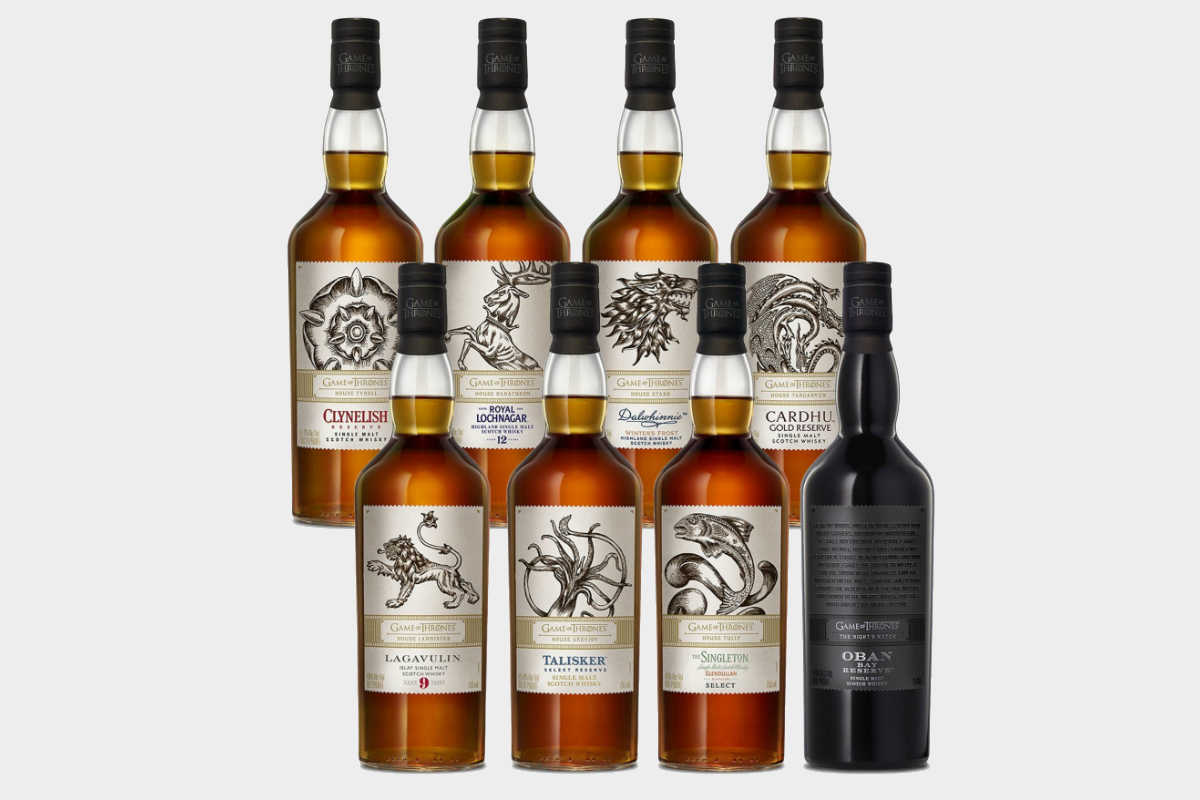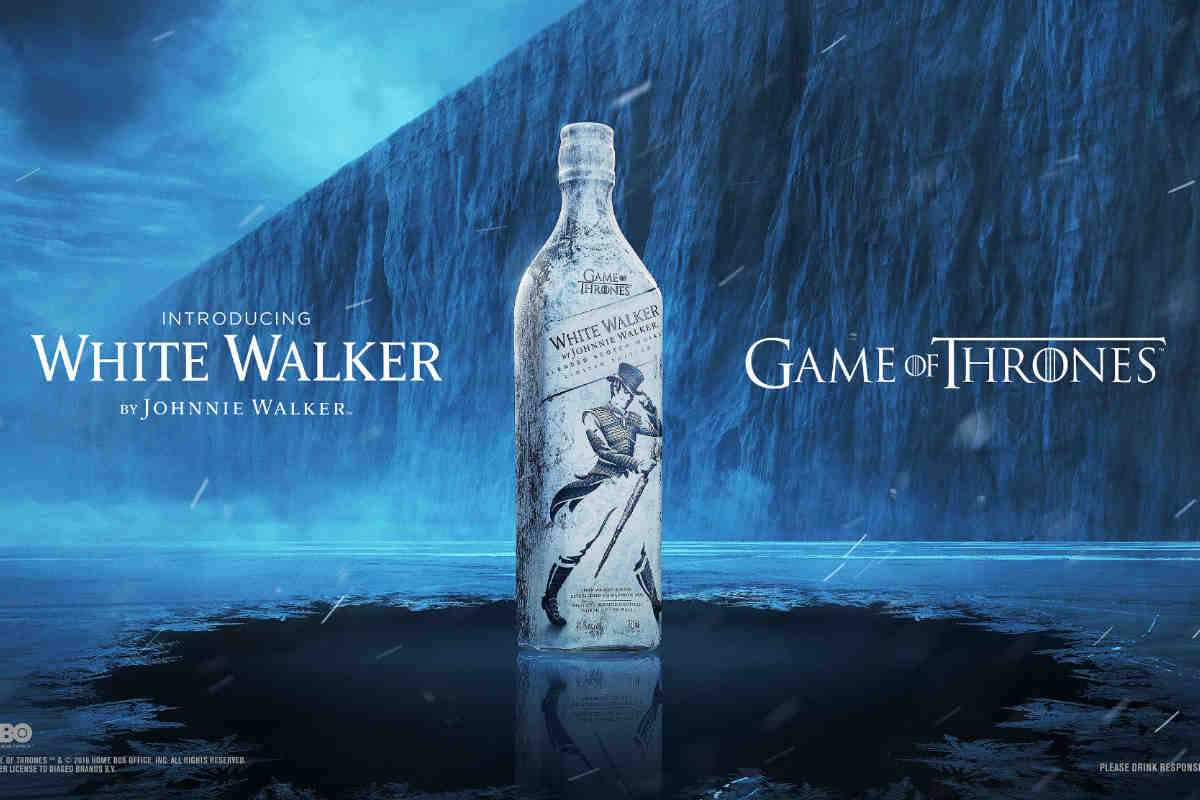If you’ve begun to wonder whether a “Game of Thrones”-themed gift shop has replaced your local whiskey aisle, you’re not alone. The last few months have seen the release of Johnnie Walker’s White Walker expression, as well as eight single malts (six of which are new expressions) from Diageo-owned distilleries like Lagavulin, Dalwhinnie, and Oban, each tied to one of the dueling houses featured in the HBO series. The final season of Game of Thrones premieres April 14, by the way, so now is a good time to pickup some bottles.
The promotion of scotch whisky through TV or film is nothing new. James Bond was known to slug back a Talisker or Macallan in his day. But the Game of Thrones blitz feels different. No longer content to merely sip whiskey onscreen, fictional worlds are leaping into the whiskey aisle in the form of entirely new releases.
There are examples that pre-date the GOT rush, too. In 2013 “Anchorman 2” inspired the creation of Ron Burgundy Great Odin’s Raven Special Reserve Scotch Whisky. The year 2017 saw GlenDronach debut its Kingsman Edition 1991 Vintage, a 2,000-bottle release tied to “Kingsman: The Golden Circle” that retailed at $900. The same movie also inspired Old Forester Statesman, a 95-proof Kentucky bourbon. White Walker isn’t Johnnie Walker’s first branded rodeo, either, as the brand also created a unique expression for “Blade Runner 2049.”
It’s enough to give a scotch lover pause. In five years, will every new bottling of Cragganmore or Cardhu be graced by the likeness of “Aquaman” or “Deadpool?” Or should we celebrate that public interest in scotch is giving everyone something new to sip on? To try and answer these questions, I reached out to a few industry experts via email.
As Seen on TV

Old Forester Statesman Bourbon. Photo: Old Forester.
“Liquor brands are getting smarter about marketing, especially as they expand into developing markets in a much bigger, and more strategic, way than in the past,” says Clay Risen, author of Single Malt: A Guide to the Whiskies of Scotland. “Tie-ins with hit movies can be a great way to raise a brand’s profile, while making them special releases (and not just about the labeling) can guarantee a certain interest among existing fans.”
Risen seems surprised that scotch whisky is only recently coming into the trend.
“It’s also a long-overdue move. Especially in the States, whisky brands have been staples in TV and movies for a long time—Jack Daniel’s and Jim Beam are classic signifiers of a certain type of hardboiled character; more recently, I’ve seen Pappy and WhistlePig pop up in ‘Justified,’ ‘Treme,’ ‘Breaking Bad,’ and ‘Billions.’ It only makes sense for whisky brands to now take the next step and leverage the value of TV and film to their own ends,” Risen says.
While Risen has mixed personal feelings about the matter, he thinks that it may prove a net plus.
“There’s something untoward and gimmicky about the whole thing. That’s just me, though. If it leads to some interesting special releases, like the ‘Game of Thrones’ series, then I think it’s good for drinkers,” Risen says.
He doesn’t see it as a drag on distillers, at least for the time being.
“As long as it doesn’t go overboard, I think it’s good for the industry. The only risk is if it becomes stale and overdone, which I imagine could happen very easily if too many distilleries get in on the game, and too many of them turn out sub-par releases. But for now, it’s a positive,” Risen says.
Finding a New Audience

Diageo’s Game of Thrones Whisky Lineup. Photo: Diageo.
Charles Maclean, an International Wine & Spirits Competition judge, Master of the Quaich, and author of Whiskypedia: A Compendium of Scotch Whisky, sees the trend as a plus “unless film companies become too greedy—as happened with product placement.”
In particular, Maclean seems happy that film tie-ins are exposing scotch to new audiences, and vice versa.
“[It’s] an excellent way to introduce non-scotch drinkers to malt, and remind consumers of the range of flavors available,” Maclean says. “It wittily builds links where none existed before, and in an entertaining way.”
Maclean is familiar with Diageo’s entire “Game of Thrones” range, having compiled tasting notes on each.
“The pairing is inspired, and the pricing reasonable enough to encourage purchasing the complete set,” he says.
The More, the Merrier?
Lew Bryson, author of Tasting Whiskey: An Insider’s Guide to the Unique Pleasures of the World’s Finest Spirits, sees the benefit of scotch whisky reaching new audiences, but feels that it may come with a catch.
“As always, more drinkers means more places that have a good scotch selection and more people exposed to scotch, which means more people who like it, which means more scotch being made,” Bryson says. However, he notes that the timing of it all can spell trouble. “It’s going to make more drinkers before it makes more whisky; demand racing ahead of supply.”
But from the standpoint of the industry, Bryson considers the trend an “unalloyed good.”
“More exposure, more intrigue, more interest, means more drinkers. More drinkers is always good, because even when the trend-chasers eventually leave, as they will, some of them will stay for the long haul, convinced of the great taste of scotch whisky.”
So, as the trend continues, it’s possible that future generations of drinkers will look back at their first, long-ago purchase and not recall whether it was a Macallan or a Glenlivet—but a Stark or a Lannister.



